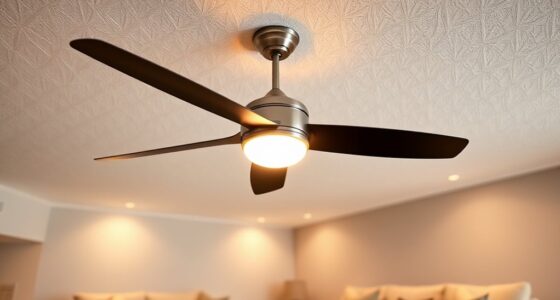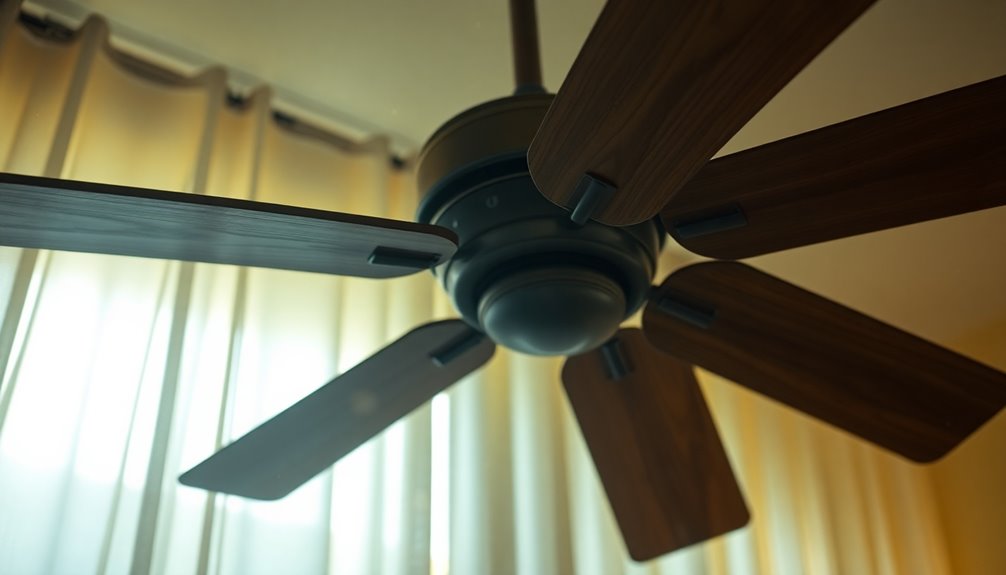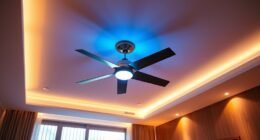If you're dealing with water leakage through a ceiling fan, start by visually inspecting the area and the fan itself for signs of water or leaks. Check the ductwork for moisture, run the fan to observe leaks, and use a moisture meter for further detection. Inspect the fan blades and housing for water stains, rust, corrosion, and ensure the blades are securely attached. Look for water stains on the ceiling, dampness near the fan, and address any musty odors promptly.
Check the roof for missing shingles, damaged flashing, and plumbing system for leaks. Safety measures are crucial—turn off circuit breakers, test dry appliances after troubleshooting, and consider professional help if needed. Remember, prompt identification and action can prevent further damage and hazards, ensuring the safety of your home and loved ones.
Key Takeaways
- Conduct visual inspection for water stains or leaks around the fan.
- Check for dampness or musty odors near the ceiling fan.
- Inspect fan blades and housing for signs of water damage.
- Address roof and plumbing issues that may cause leaks.
- Prioritize safety by turning off power before troubleshooting.
Identifying the Water Leakage Source
To pinpoint the source of water leakage through a ceiling fan, I recommend conducting a visual inspection of the surrounding area and the fan itself. Look for any signs of leaking water or ceiling leaks that could be causing the issue. Check the ductwork for any moisture accumulation as well.
Running the ceiling fan can also help in observing any leaks while keeping an eye out for water stains on the ceiling. If you have a moisture meter, use it to detect the presence of water in the affected areas.
Identifying the source of water leakage is crucial in addressing the problem effectively. Once you have located the source, you can take necessary steps such as sealing gaps around the fan with caulk, repairing roof leaks promptly, and addressing any plumbing issues contributing to the water leakage.
Inspecting Fan Blades and Housing

When troubleshooting water leakage through a ceiling fan, it's crucial to start by inspecting the fan blades and housing.
Check for any water stains, rust, or corrosion as indicators of potential water damage.
Ensure the blades are securely attached and examine hard-to-reach areas for any signs of water accumulation.
Blade Condition Check
Inspect the fan blades and housing for any signs of water damage or discoloration. When checking the blade condition, pay attention to the following:
- Look for warping, cracking, or water stains on the fan blades that may indicate water leakage.
- Check for rust or corrosion on both the fan blades and housing, as these can result from exposure to water.
- Ensure that the fan blades are securely attached and not loose, as water leakage can impact their stability.
- Use a flashlight to closely examine the fan blades and housing for any water-related issues.
This thorough inspection will help identify any potential problems caused by water damage and leakage, allowing for timely troubleshooting and maintenance.
Housing Seal Inspection
Upon examining the fan blades and housing for any water-related issues, the next step is to thoroughly inspect the housing seal for signs of wear, cracks, or gaps that may allow water leakage.
A damaged housing seal can lead to water seeping through, causing ceiling leaks and potential damage. Look closely for any visible wear and tear that could compromise the seal's integrity. Check for gaps where water could penetrate and ensure that the seal is intact.
Rust or corrosion on the housing components may indicate water infiltration, requiring prompt attention. By maintaining a secure and well-sealed housing, you can prevent water from leaking through the ceiling and keep your fan functioning properly.
Regular inspections will help identify and address any housing seal issues before they escalate.
Checking for Water Stains and Dampness
To identify water leakage through a ceiling fan, I recommend first looking for visible water stains or damp areas on the ceiling surrounding the fan. When troubleshooting for water stains and dampness, consider the following:
- Look for water stains on the ceiling to pinpoint the source of the leak.
- Check for dampness or discoloration near the fan for signs of water leakage.
- Pay attention to any musty odors or mold growth, indicating water infiltration.
- Use a moisture meter to detect hidden moisture levels in the ceiling near the fan.
Addressing Roof and Plumbing Issues

First, let's inspect the roof for missing shingles or damaged flashing to determine if that's causing the water leakage through the ceiling fan.
Next, we should check the plumbing system for any leaks, such as cracked pipes or faulty connections, which could be contributing to the issue.
Identifying and addressing these roof and plumbing issues promptly is crucial in resolving the water leakage problem effectively.
Roof Inspection Tips
When inspecting a roof for potential water leakage issues affecting a ceiling fan, it's crucial to thoroughly examine the condition of the shingles, flashing, gutters, and plumbing components to identify and address any underlying problems effectively.
Check for missing, cracked, or damaged shingles that could be causing leaks.
Inspect the flashing around vents, chimneys, and skylights for signs of deterioration.
Clear clogged gutters and downspouts to prevent roof leaks.
Examine the attic for water stains, mold growth, or wet insulation indicating roof leaks.
Plumbing System Check
Inspecting the plumbing system is essential to address both roof and plumbing issues that may contribute to water leakage through a ceiling fan. When dealing with water leaks, it's crucial to check for any leaking pipes or faulty connections that could be the source of the leak affecting your ceiling fan.
Additionally, a leaking shower or an issue with your plumbing in the bathroom can lead to water leakage through the ceiling fan. By conducting a thorough plumbing system check, you can pinpoint the source of the leak and take the necessary steps to fix it promptly.
Addressing any plumbing issues will help prevent further water damage and ensure a dry and safe environment in your home.
Safety Measures During Troubleshooting

To ensure safety during troubleshooting, always remember to turn off the circuit breakers before starting any work on a ceiling fan experiencing water leakage. Here are some safety measures to follow:
- Use a non-contact voltage tester to confirm that the power is cut off before attempting any troubleshooting to prevent electrical shock.
- Avoid touching wall switches to minimize the risk of electrical shock during the troubleshooting process.
- Dry appliances should be tested after troubleshooting, but fixtures or fans shouldn't be tested to prevent potential hazards.
- Seek professional help to safely remove fixtures and fans during troubleshooting to avoid accidents or further damage.
Following these safety measures is crucial to protect yourself from potential electrical hazards when dealing with water leaking through a ceiling fan. By prioritizing safety, you can effectively troubleshoot the issue while minimizing risks.
Preventing Electrical Hazards

One critical step in preventing electrical hazards related to water leakage through a ceiling fan is ensuring that circuit breakers are promptly turned off. When water infiltrates the ceiling fan and light fixtures, the risk of an electrical fire escalates. To mitigate this danger, it's essential to cut off the power source by switching off the circuit breakers.
Additionally, refrain from touching wall switches in the affected area to avoid the possibility of electrical shock. Using a non-contact voltage tester can assist in verifying that the power supply to the ceiling fan has been effectively disconnected, adding an extra layer of safety during troubleshooting.
Professional Assistance Considerations

When dealing with water leakage through a ceiling fan, the involvement of certified electricians for handling fixture removal is crucial to ensure safety. Professional assistance plays a key role in identifying and addressing the source of leaks in ceiling fans connected to electrical components.
Here are some considerations to keep in mind:
- Expertise Matters: Certified professionals have the knowledge and skills to handle electrical components safely.
- Safety First: Professionals can prevent hazards associated with water leaks and electrical systems.
- Accurate Diagnosis: Professional help ensures the correct identification of the leak source, preventing future issues.
- Preventive Measures: Seeking professional assistance early can help avoid worsening the situation and costly repairs.
When it comes to leaks involving electrical components and water supply, trusting experts for assistance is vital in maintaining safety and resolving the problem effectively.
Prompt Leak Source Identification

Identifying the source of a leak promptly is essential in preventing further damage and hazards associated with water leakage through a ceiling fan. When your ceiling is leaking and water is dripping through the fan, it's crucial to take action swiftly. Check for any visible signs of a damaged pipe or look at the roof for potential entry points. If the cause is not readily apparent, you may need to call a professional for assistance. Here's a quick reference table to help you identify the leak source effectively:
| Possible Causes | Action Needed |
|---|---|
| Damaged Pipe | Check for leaks and repair if necessary |
| Roof Issues | Inspect the roof for any damage or missing shingles |
| Condensation Buildup | Improve ventilation and insulation in the attic |
Frequently Asked Questions
What to Do if Water Leaks From Ceiling Fan?
If water leaks from a ceiling fan, inspect the fan for any damage. Identify the water source and turn off electricity for safety.
Consider repair options and prioritize electrical safety. Seek professional help to assess and fix the issue.
Never touch the fan or light fixture to avoid electric shock. Taking swift action can prevent further damage and potential electrical fires.
What to Do if Water Leaks Through Light Fitting?
When water leaks through a light fixture, immediate action is crucial. Turn off the power to prevent electrical accidents.
Seek professional help for leak detection, repair, and ensuring electrical safety. Water damage can pose risks like electrical shock and fire hazards.
Maintaining ceiling fan maintenance is key to prevent such issues. Safety first – address the leak promptly to avoid further damage and ensure a secure environment.
What Troubleshooting Would You Suggest for a Leak Appearing on a Ceiling?
When troubleshooting a leak appearing on a ceiling, my approach involves inspecting the area for visible water damage, using a moisture meter to pinpoint the source, and sealing any gaps to prevent further leakage.
Regular maintenance and prompt repairs are key in preventing water damage and maintaining a healthy home environment. These proactive steps ensure the longevity of your ceiling and the safety of your living space.
How Do You Fix Ceiling Seepage?
To fix ceiling seepage, first, detect the leak's source by inspecting the fan, surrounding area for water damage. Once identified, repair the issue by sealing leaks, addressing plumbing or roof problems, and maintaining proper ventilation.
Regular fan inspections and maintenance are crucial to prevent future leaks. Remember, professional help might be necessary for extensive seepage or when DIY fixes don't work. Prioritize safety and thorough solutions for lasting results.
Can Improper Disposal of Ceiling Fans Lead to Water Leakage Issues?
Improperly disposing old ceiling fans sustainably can lead to water leakage issues. When fans are not disposed of properly, they can end up clogging drainage systems, causing water to backup and leak into homes. It’s important to dispose of old ceiling fans in a sustainable manner to avoid these potential issues.
Conclusion
In conclusion, identifying the source of water leakage through a ceiling fan is crucial for effective troubleshooting.
By inspecting fan blades, checking for water stains, and addressing roof and plumbing issues promptly, you can prevent further damage.
Remember, safety is key during this process. Keep an eye out for potential electrical hazards and consider seeking professional assistance if needed.
Stay vigilant and proactive to ensure a dry and safe environment in your home.









